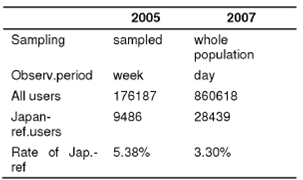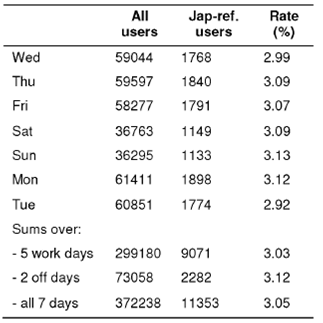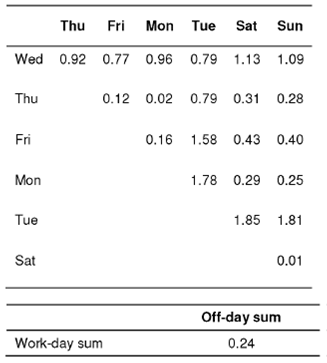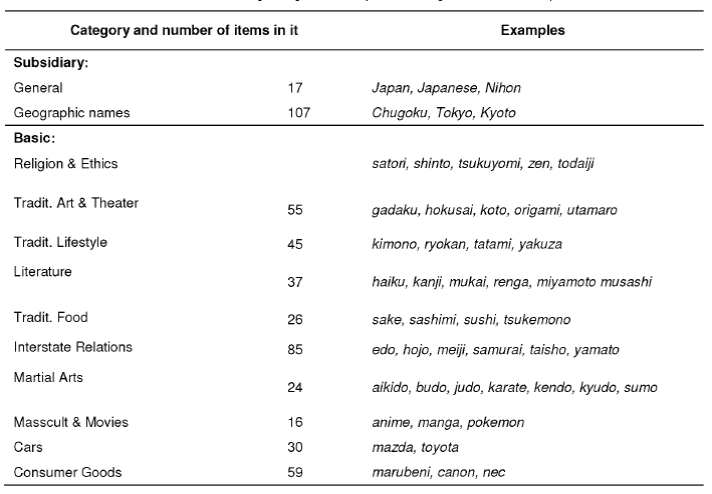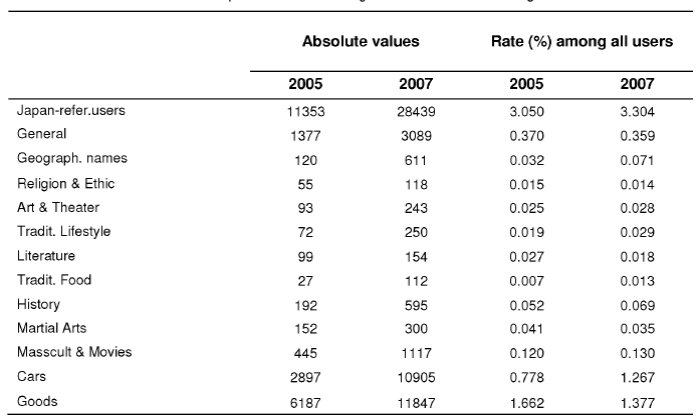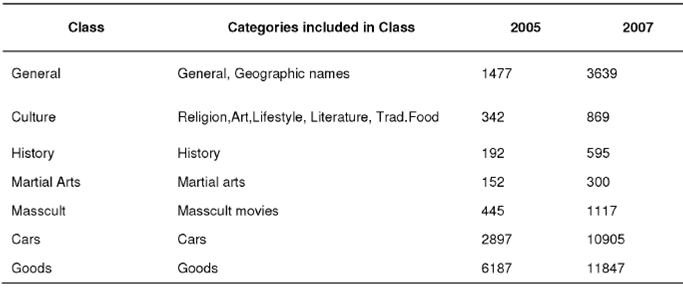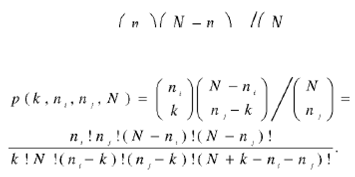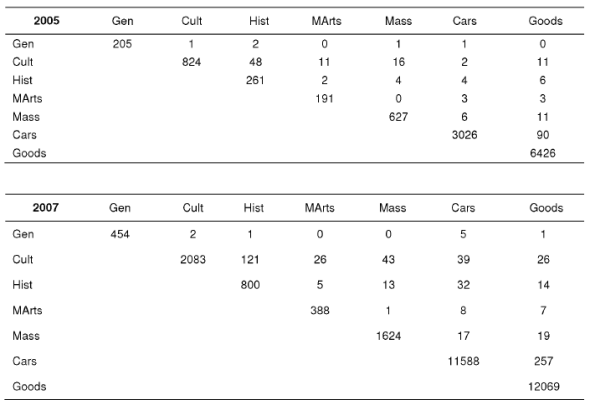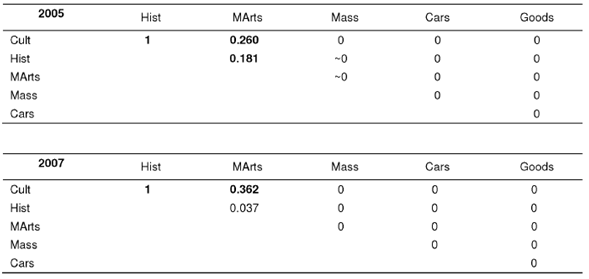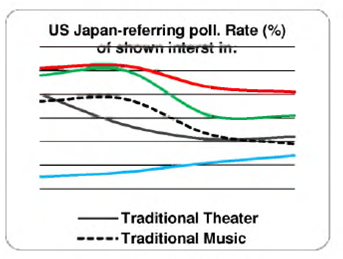1 Introduction
Among three questions considered by the researchers of the Web search," Who searches the Web?' (subjects), "What do they search for?' (objects) and "How do they search?' (search tactics), the first two questions primarily relate to the applied sociology. The Web era has opened not only a new field of social activity but also a huge source of the data for a sociological analysis of public interests. The ways to interpret a huge collection of the very small units (queries) are obviously limited. Logs as such give no possibility to reveal either the attitudes or the origins of interests (except when a query is the result of another query). The query logs are a huge, representative, straight (vouched by submitted queries, cf. declarations in polls), long-term but not self-contained, and small-element base for causal inferences.
While sociology of the Web mainly answers the question "Who searches the Web?' (age, gender, etc.) and uses polls, the sociology of query logs answers the question "What do they search for?' and uses query logs. The common subject of the Web log based sociology is a classification of queries by the topics searched, e.g., "sex", "commerce" 4, 5, 7,10,13. The manual attribution of queries was used in the early studies. More sociologically sophisticated studies such as 12, 16 are rare.
Query log-based works are frequently insufficient both in terms of sociological tasks (in particular, interdependences of the investigated factors are out of study) and statistical methods used. Also they are not always sophisticated in terms of query topic detection techniques. The aim of this paper is to describe a nearly standard procedure of topic detection as a part of a methodologically full-value query log-based sociological study.
Web search engines' query logs data may be used individually and in combination with data extracted from other sources (e.g. polls) in the form of sociological data fusion. Since information extracted from queries is obviously insufficient for explanation of dependencies and changes, the second way seems to be more appropriate when we should correctly explain interdependences or changes. But the data fusion problems are out of this study and we follow the first approach without technically correct invoking external socioeconomic information.
The rest of the paper is organized as follows. In Section 2, goals and technical problems of query log sociology are stated. The research questions of the illustrative longitudinal query log-based sociological study are formulated in Section 3. Section 4 describes the datasets used. The typical sequence of steps of the topic detection-based sociological study of query logs is given in Section 5. Section 6 presents measures used in the sociological study of the changes of the cross-nation search image based on two-year spaced query logs of the same national audience, Section 7 describes the results of the study, and Section 8 presents conclusions.
2 Object and Tasks of Sociology of Query Logs and Query Topic Detection
Objects. Anonymized "query log" datasets are the main base for query log sociology (a useful source of query specification in terms of user age, gender, etc. is personal data available only for search engines' teams and used in their targeting advertising). The datasets are combinations of records of several logs of the search engine and contain transaction descriptions grouped by user and ordered by time for each user. The datasets usually include "user" (i.e. cookie) identifier (UID), query string, timestamp of the transaction, and page number of the retrieved results.
Goals and tasks of sociology of query logs. The primary task of any query log-based sociological study is a perfect unambiguous attribution of users/queries according to the classification used in the study.
When objects (queries, users) are attributed, the further processing is a usual sociological study of the classes' rates, interrelations, and changes, and does not depend on the specific nature of the queries. To explain the facts revealed in the query log analysis we need to use external, "out-log" knowledge and data, e.g. what social, cultural, political events may determine interests expressed in queries.
The main technical problem is an auxiliary task of automated creating of tools of an automatic classification of queries. Numerous works (e.g., 1, 3,6,9,11,14,15)) started by 2, 8 are devoted to query topic detection, including query attribution to predefined thematic classes, and give particular methods of query categorization widely used in contextual online advertising.
A machine learning approach based on the creation of learning samples of queries is not only too expensive but also inappropriate when the objects of interest are too rare. For example, Japan-referring queries are rare neighbors in search sessions and the majority of them is so rare that manual detection of a single query 'mukai' for learning sample passes into a manual detection of all 'mukai' queries. An alternative way is the use of initial topical vocabulary of keyword(-combination)s, its modification during a study and a usage of simple classification rules. The task and tools are similar to the task and tools of the (keyword-based) contextual advertising. The aim is a perfect unambiguous attribution of a query (a sequence of user's queries) to classes considered.
While the tools of the query log-based sociology are similar to the tools of the contextual online advertising, we do not observe query-log sociology flourish. The curious and unavoidable curse of query log-based sociology is that available logs, "the huge source for a longitude sociological analysis", are rare and irregular. Query log providing for non-adversarial researches is a matter of a good and disinterested will of search engines' teams.
3 Longitudinal Study and Its Research Questions
A complete study. The paper describes from scratch all steps of a methodologically complete query log-based sociological study exemplified by a study of queries submitted by the same national audience (Russian) searching for the topics related to the other state (Japan). Two logs (2005 and 2007) of the main Russian search engine Yandex are used.
We consider topic categories of queries related to Japan (e.g. Japan culture, Japan goods, etc.) to categorize users submitting these queries in terms of Japan-referring classes. It is of particular interest to study co-relation between topic classes of users and changes of the rates and classes co-relations during two years. The datasets used in the study are a good base for intra-audience estimates, particularly for detection of the two-year changes of the audience interests.
The reason for choosing Japan as a "perceived object" is that the choice of a "language-exotic" object decreases the problem of recognition and disambiguation of topical queries and simplifies an automatic classification of queries.
Research questions. The subject of the particular illustrative study is a search engine user as a set of all queries submitted from the same cookie. As a result, a single user may include all people who submit queries from the same cookie during the observation period. A user who submitted queries belonging to several Japan-referring classes is attributed to all these classes (that is, user classes intersect). The research questions are:
- Classes' frequencies and their changes in the Russian search audience from 2005 to 2007;
- Classes' co-occurrence and their changes over these two years.
The analysis of two Yandex logs may be considered as a methodologically complete fragment of a full-value longitude study of the Russian audience. However, the primary goal of the paper is to demonstrate the potentials and techniques, so the relative (but usual for log studies) weakness of the dataset corpus is far from being the weakness of the method.
4 Datasets and Two-Year Changes of Audience
Two datasets are used in the study: 24-hour complete query logs of the Russian Yandex search engine (March 20, 2007, Tuesday) and 7-day sample of the Yandex (March 9-15, 2005). The preprocessed datasets after elimination of users with broken log records and users detected as robots are given in Table 1.
Two questions arise: (1) about differences in conditions of observations (2005 week sample vs 2007 one-day complete dataset) and (2) about structural similarity of audiences (probable determiners are a sex-age and an access (office/home/mobile) structures, and a possible determiner is a geographical distribution (metropolitan vs province)). While rates of users from non-metropolitan areas and young users have increased ((18, 19)), we can consider 2005 and 2007 audiences as the same Russian audience.
A comparison of over-a-day 2007 frequencies with over-a-week 2005 frequencies is not valid (if the probability p(day) to submit 1+ Japan-referring queries throughout a day was equal to 0.03 for any user, then the probability to submit Japan-referring queries during 7 days would be p(7days) = 1 - (1-p(day)) 7 = 0.1911. But since the probability to submit Japan-referring queries once again is bigger for the users submitted such queries earlier, the observed 7-day frequency of Japan-referring users pobs(7days)=0.0538 is less than p(7days), see Table 1).
Fortunately, due to random sampling of users in the Yandex-05 dataset we can consider 7 one-day datasets instead of a week dataset (Table 2).
Reported in Table 3 Yates corrected z-values (see Section 6.2) for rates of Japan-referring users in each day-to-day pair and in work-day sum vs off-day sum are smaller than the critical z0.S5 = 1.96. Since no significant difference between the frequencies of Japan-referring users in any pair of days is observed, we can join one-day sets and use a sum of 7 one-day sets as a one-day representation of the Yandex-05 week data. As a result of this statistically correct trick, we use the virtual one-day set of 372,238 virtual users instead of a set of 176,187 initial real users.
5 Steps of Query Topic Classification
In this section, the complete sequence of data mining steps of any query log-based sociological study is described from scratch.
It is worthy of note that the specific nature of the Japan-related topics significantly simplifies tool creation (mainly non-dictionary words) and an application (mainly unambiguous topical attribution).
The basic tool of the study is a thematic Japan-referring Russian vocabulary containing topically attributed keywords and keyword-combinations named "the vocabulary". The words not included in the vocabulary are referred to as non-vocabulary. The standard Russian electronic dictionary is referred to as "dictionary, and words non-included in this dictionary are referred to as non-dictionary.
All vocabulary creation/modification actions below are two-stage: (1) an automatic extraction of words/combinations as candidates for inclusion in the vocabulary, (2) a manual approval of candidates and attribution of them to vocabulary topics.
5.1 Step 1. Japan-referring Topics Selection and Initial Thematic Japan-referring Vocabulary Creation
We identify searchers curious about Japan-referring topics by their submission of at least one Japan-referring query. To detect these queries we need to create a Japan-referring thematic vocabulary that includes words and word-combinations marked by the word topic categories.
a. Word Categories
To detect and categorize Japan-referring words, queries, and users, we set up two kinds of categories: (1) ten basic categories corresponding to both aspects (a general reference to Japan and a certain thematic denotation, e.g., religion, lifestyle, etc.) and (2) two subsidiary categories, General and Geographic names, used to detect those Japan-referring queries, which cannot be attributed to basic categories. Queries attributed to subsidiary categories should be re-categorized where possible into the basic categories in the next steps.
b. Initial Vocabulary Creation
(1) Data. A small Russian-language corpus of Japan-referring texts and a big Russian-language corpus of non-Japan-referring texts.
(2) A tool for non-dictionary word extraction: Russian electronic dictionary.
(3) Procedure
(3.1) Two ways of automatic extraction of candidates: (3.1 .a) non-dictionary words and word-combinations in the corpus of Japan-referring texts; (3.1.b) words significantly more frequent in Russian Japan-referring texts than in Russian non-Japan-referring texts.
(3.2) Manual approval of candidates, bilingual parallelization, and categorization in terms of basic categories. Almost all non-dictionary words and word-combinations detected by (3.1.a) and only a few too-frequent words detected by (3.1.b) were approved as Japan-referring words and word combinations. The extracted Russian spellings were attributed to basic categories.
Besides, words from the General category and brand names (Cars and Consumer Goods categories) were included manually.
The distributions of words among the categories are shown in Table 4. The initial categorization allows a multi-valued word attribution, e.g. kotatsu belongs to both Religion and Lifestyle categories. Thus, initial word categories are overlap.
5.2 Step 2. Trial Run
Initial detection of Japan-referring users and vocabulary expansion. In this step, each query is attributed to all categories of the vocabulary words contained in the query and a user is attributed to all categories of queries submitted by her.
Query processing. The vocabulary contains words and (two-)word-combinations. Word-combinations are detected (and eliminated from the further processing of this query) first, and then the vocabulary words are detected in the rest of the query. E.g., a combination "japan culture" (which will be added to the vocabulary only in Step 3 among other combinations) rather than "japan-should be detected first in the query <school essay japan culture downloads
The aims of Step 2 are
(1) a rough evaluation of the number of users attributed to each category.
(1.1) If the number of users marked by the subsidiary categories is big enough, then the words from these categories should be specified by their collocations in queries and as possible be re-categorized in terms of the basic classes. E. g., such combinations as <kyoto temples> or <yokohama tiers> should be attributed to the basic classes.
(1.2) If the number of users attributed to a basic category is small, then the category should be combined with another categories according to their thematic similarity. Another reason for combining categories is that we need to construct the vocabulary with non-overlapping word classes.
(2) An automatic detection of frequent misprints and non-unique spellings of the vocabulary words to include these spellings in the vocabulary. If a word in a query is non-Russian and differs from some Japan-referring vocabulary word by one or two symbols (for more than 6-symbol long words), the word is detected as a probable misprint or non-unique spelling (e.g., mitsubishi and mičubisi in Russian). All detected words are inspected for a mass presence in the Web and if presented they are checked manually. The approved spellings are added to the vocabulary, and only exact match with vocabulary words is taken as due account in the further study.
Table 5 shows the categorization of the users according to the queries submitted by them.
a. Combining Categories into Compound Classes
Small (in terms of the users attributed) and closely topically related basic categories are aggregated into compound classes. Two subsidiary categories are aggregated into the General class. Table 6 shows the resulting compound classes and the number of users attributed to them. Since user categories intersect, the number of users in the compound classes is smaller than the sum of users in the combined categories. Now, the word classes do not intersect while the corresponding classes of users may intersect and do intersect.
b. Vocabulary Mutation
(1) Expansion of subsidiary words by (non-Japan-referring) dictionary words and re-attribution of detected combinations to basic classes.
Since the number of users attributed to subsidiary categories is big, the words from these categories should be specified by their in-query collocations and these combinations should be re-categorized as possible in terms of the basic classes. E.g., a combination Kyoto castles should be attributed to the Culture class against to attribution of Kyoto to the General class.
Procedure.
(a) A non-Japan-referring dictionary word w more frequently collocated in queries with a General class word Wthan w which appears in all other queries is automatically extracted as a candidate for a combination <wi W> attributed to some basic class.
(b) The list of extracted word-combinations is checked manually and approved candidates are inserted into the appropriate word class. When <wi W> is approved, the status of Wis not affected.
The results of the procedure are very successful and give 43 word-combinations such as Japan history, Japan culture (it is worthy of noting that school essay is a very frequent co-locator of these combinations). An impressive example is an expansion of yokohama. This geographic name frequently appears in the Yandex logs. However, all 23 yokohama occurrences are occurrences of yokohama tiers combination (Cars).
The dramatic change in the sizes of user classes in Table 7 (cf. Table 6) is the result of the subsidiary word expansion with dictionary non-vocabulary words.
Definitions.
A temporal session is defined as a sequence of the user queries cut from previous and successive sessions by a certain time gap. A task session is technically defined as a connected component of the lexical similarity graph of queries submitted during a temporal session. When we extract task sessions, we use 30-min time gap. But as a result of lexical task session detection, it is unlikely that queries containing unknown Japan-referring words will be included into the task session detected as Japan-referring. For this reason, we also use short-gap temporal sessions with a 5-min time gap. One can expect that Japan-referring queries are close intime.
(2) New Japan-referring word extraction.
One can expect that non-vocabulary Japan-referring words more frequently appear in (a) queries containing words from the vocabulary, (b) task sessions containing such queries, and (c) short-gap temporal sessions containing such queries. Just as in the candidates' extraction from the Japan-related texts in Step 1, we suppose that (non-vocabulary) Japan-referring words in queries are non-dictionary. As a result, all non-dictionary words are automatically extracted from Japan-referring queries and task and short-gap sessions.
The results of the procedure are far from being successful. While a lot of non-dictionary spellings are automatically detected in Japan-referring queries and task sessions, neither of them is Japan-referring words. Several non-dictionary words detected in short-gap temporal sessions are really Japan-referring words attributed to Culture, History, and Martial Arts classes. But the expansion of these word classes yields no results in the user classes since only users earlier detected as Japan-referring use these words.
6 The User Class Co-Relation Measure and Tests Used
6.1 Inter-Class Co-Relation Measure (One-Tailed Fisher's Exact Test Measure)
To detect closely interrelated and "incompatible-classes in the dataset, we estimate the probability of a random co-occurrence for each pair of classes of Japan-referring users. The bigger the probability that an intersection of two classes is not bigger than the observed intersection, the stronger inter-class co-relation is.
Let m be the number of users attributed to the class / (diagonal elements in "contingency table of classes"), obs(i,j) be the number of users attributed to both classes i and j (non-diagonal elements), and N be the number of all considered users.
To measure the strength of the interrelation between two classes we use the probability p(k ≤ obs(i,j)) that the number of random cooccurrences k of the independent classes i and j (containing n, and ns users) is not bigger than the observed intersection obs(i,j). This measure shows to what extent the observed interrelation is incompatible with the assumption of independence of the classes. The bigger p(k ≤ obs (i, j)), the stronger the interrelation is.
where p(k, ni nj N) is a hypergeometric probability of k co-occurrences of n, marks of the type i and ns marks of the type j which are independently used to mark N "cells":
When classes are small, the measure of co-relation is of low reliability since even a small (1-2 items) variation in the number of co-occurred items greatly changes the measure.
Two variants of the co-relation measure.
Beside an obvious population of all users, we also calculate the measure for the only Japan-referring users' population. The reason for using the latter, "artificial" variant is that Japan-referring classes are expectedly co-related and we want to visualize the difference between the strong and the strongest co-relations. While both measure variants give the same ranking of co-relations, the former variant ("among all users") clearly shows independence (and even "incompatibleness") of classes and the latter variant ("among only Japan-referring users") is more appropriate for visualization of strong co-relations.
Small probabilities in the "among all users-measure are markers of incompatibility of classes. Significant probabilities in the "among only Japan-referring users" measure clearly show the closest co-relation between classes.
6.2 Tests for Two-Year Change Detection
To compare the rates of the same Japan-referring class among all users in two logs, we use z-test in the Yates' corrected form:
where p1 and p2 are sample rates for the corresponding class in each of two datasets and p is a sample rate in a combined population.
To test the similarity of the proportions of k user classes in two logs, we use x2 test with (k-1) degrees of freedom. Since expected intersections of independent classes are smaller than 5, we do not use x2 test (with (k+1)k/2-1 degrees of freedom) to test for similarity of classes' cooccurrence in two datasets.
7 Particular Study Results, Changes of Rates, and Co-Relations
User classes detected under vocabulary are shown in Table 7. the mutated
Table 7 User classes, their rates among all users, and Yates corrected zvalues (similar rates are in bold)
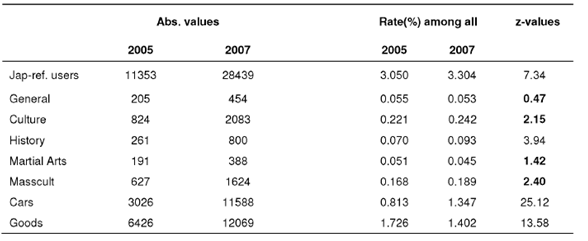
7.1 Changes of Rates and Proportions of User Classes
Rates of user classes among all users. We assign the critical level of difference for Japan-referring classes among all users to 0.99 (z0.99 = 2.58). The rates with sample z-value smaller than z0.99 are considered as similar and are given in bold in Table 7.
Two-year changes of Japan-referring interests. There are no changes in the rates of Culture, Masscult, and Martial arts classes. The History rate grows.
However, the mostly impressing are the opposing changes in the rates of "consumer classes": enormous growth of the Cars rate against a significant decrease of the Goods rate during two years.
Proportions between user classes among Japan-referring users. The observed x2 value for distributions of 7 classes equals to 805.9 while critical x2(6 d.f., p=0.95) = 12.6. Thus, no similarity of proportions in the 2007 and 2005 data is observed.
7.2 Changes of Co-Occurrence of User Classes
The co-relation of classes is the most interesting part of the study. Table 8 shows co-occurrence of Japan-referring user classes. The differences between the sums of the diagonal elements (sizes of classes) and the sums of the elements below (or above) the diagonal (sizes of pairwise intersections of classes) are only slightly less than the number of Japan-referring users. So we can ignore the cooccurrence of 3+ classes.
Probability distributions of intersections of all pairs of independent classes are near-symmetric but have a cropped left tail except the pairs containing big Cars and Goods classes (see Fig. 1 presenting probabilities of intersections of the Culture class with other classes). A center of the distribution for a pair of small classes is only a little bigger than 0 and even the minimal probability of intersection p(k ≤ 0) is big enough. This is an additional reason why the reliability of big p(k ≤ obs (i,j)) for intersections of small classes is smaller than the reliability of the same or smaller values for big classes.

Fig. 1 Probabilities of intersections of the Culture class with other classes among all 2005 (top) and 2007 (bottom) users (observed intersections are given in brackets)
a. Class Independence Changes over Two Years
Table 9 presents the probabilities p(k ≤ obs (i, j)) of the class co-occurrence in the all users population. They are, for the most part, too big for a random co-occurrence of independent classes.
Table 9 Independence of basic user classes in the all users population (incompatible is given in bold italic, near independent are given in bold)
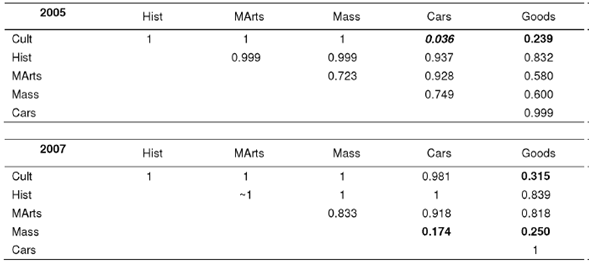
But some pairs show incompatibility of classes that cannot be interpreted as an artifact caused by the small size of the classes (Masscult and Cars are big classes).
Both 2005 and 2007 logs show incompatibility of the Culture and Goods classes. On the contrary, while the big Culture and Cars classes are strongly incompatible in 2005, they are co-related in 2007. Other two-year changes are: Masscult changed its co-relations with consuming classes from nearly independent in 2005 to incompatible in 2007. The former may be an artifact caused by the small size of the Martial Arts class. But changes in Culture and Cars, or incompatibility of the Masscult and Cars and Goods in 2007, cannot be explained by a small size of the classes but can be explained by age differences. We can suppose that Masscult class corresponds to young people while consumer classes, especially Cars, correspond to adults.
b. "Over-Strong Co-Relation"
Probabilities of class co-occurrence among only Japan-referring searchers ("over-strong co-relation" measure) are given in Table 10. The Russian audience shows some strong co-related classes, particularly, the strong tripolar mutual gravity of Culture, History, and Martial Arts both in 2005 and 2007.
7.3 Surprising Dynamics?
Two-year big changes in Japan-referring interests of the Russian searcher audience are revealed. Is it a big surprise? To answer, we should consider changes in any similar sociological study. The only similar longitude is a Japan-referring US poll 17. Fig. 2 shows 3-year dynamics of positive answers to "For each of the areas of Japanese culture tell me if you are interested in the topic" 17 (a question asked beginning from 2011). Although the verity of poll answers sometimes is not far from the verity of personal data in users' accounts, the results reported in 12 show a possibility of wide range of changes.
8 Conclusions
We have investigated (1) the rates of the topical classes and inter-class relations in two (2005 and 2007) Russian search images of Japan presented in the Yandex logs, and (2) two-year changes in the Russian search image. The findings of this particular query log-based sociological study of class rates, co-relations, and two-year changes in them are as follows.
(1) Rates of the Japan-referring classes and changes in rates (see Table 7). There are no two-year changes in the rates of Culture, Masscult and Martial Arts classes of Russian searchers. The rate of the History class grows. The "consumer classes" (Cars and Goods) demonstrate rapid, strong, and opposing changes: an enormous growth of the Cars rate against a significant decrease of the Goods rate over two years.
(2) Class co-relations: independence and strong co-relation and changes in these relations. There are three pairs of independent classes in 2005: Culture is "incompatible" with Cars and Goods, and Masscult is absolutely incompatible with Martial Arts (the latter incompatibleness may be an artifact resulted from the small size of the Martial Arts class). However, two years later the role of Culture is played by Masscult: the Masscult class is "incompatible" with both consumer classes, while Culture is compatible with Cars (see Table 9). On the contrary, there is no change in the strongest co-relation between the Culture, History, and Martial Arts classes (see Table 10).
Of course, the results of the exemplifying study may be not without interest. However, the primary goal of the undertaken study is to demonstrate capabilities of the query log-based sociology rather than the specific results on the particular datasets.
The study shows that regardless of the very short data units, query logs provide a sufficient base for sound sociological conclusions. The obvious advantage of the query log-base sociology over polls is reliable data. And anyway, Web search engines' query logs data deserves the right to be one of the sources for sociological data fusion.











 text new page (beta)
text new page (beta)

